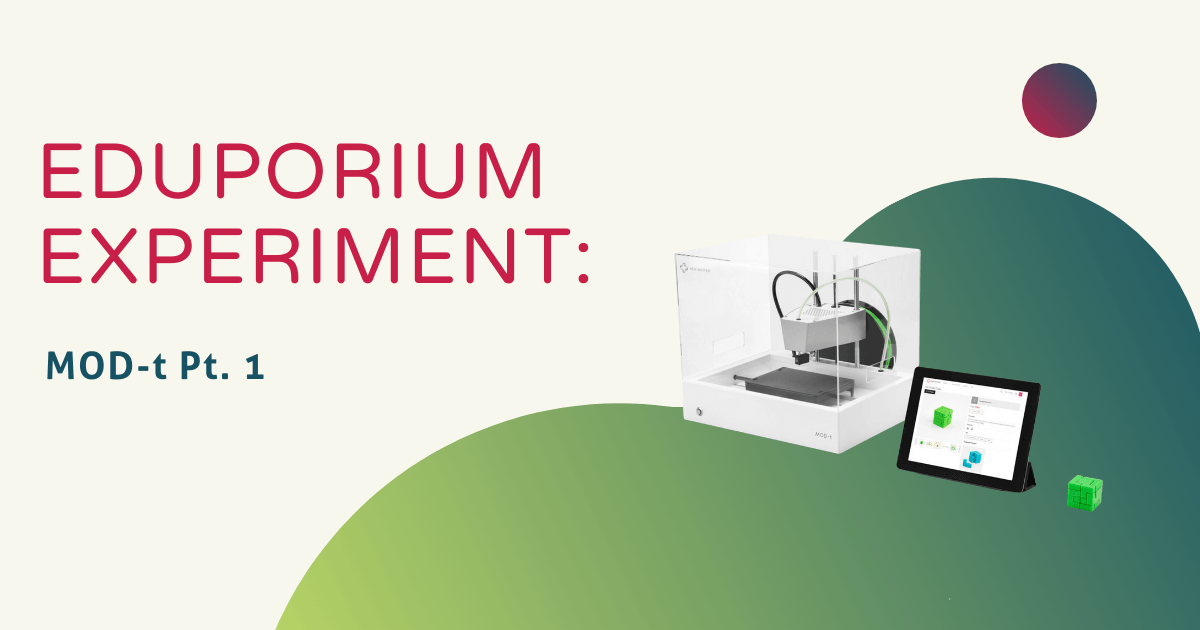If you keep tabs on the fascinating world of innovative education, you know that 3D printing is a very hot topic in the STEAM world right now. With ever-advancing 3D printing technology, simple or complex objects can be designed and manufactured efficiently and cheaply. Understanding 3D printing, its benefits, and its uses are critical pieces of 21st century STEAM learning, which is why, at the Eduporium office, we have begun researching and stocking the best 3D printers on the market today.
At the front of this large pack is the NEW Matter MOD-t 3D printer, the “first and only affordable, fully integrated, end-to-end consumer 3D printing experience.” The MOD-t is a simple desktop 3D printer, suitable for use at home or in the classroom. With all it claims to be, I was excited to try it out for myself in this week’s Eduporium Experiment.
Before I even turned the MOD-t on, I noticed that its design was simple and elegant. The machine itself is completely encased by a removable, sturdy, plastic cover, which keeps the surface around the MOD-t safe, clean, and free of loose filament (that’s the stuff the printer uses to create objects). The printer itself measures about one foot in all dimensions, making it small enough to place on any flat surface, and it can fit in just about any room in a house or school. It is light enough that I could easily lift it on my own (which isn’t always easy for me, since I’m a fairly small, light person). So far, so good! But I still wanted to create something of my own and I had a feeling there would be plenty of opportunity for that.
Of course, starting any project is difficult if you don’t know what you want to make. Thankfully, New Matter took care of that issue for me. Since the MOD-t is controlled via an Internet connection (either Ethernet or wireless), I opened up the MOD-t website and quickly found a massive library of pre-made 3D models, all of which were guaranteed to be compatible with the MOD-t printer—a perk you definitely don’t get with all 3D printers. I decided to print a new tag for my dog, Mani. The project was very easy to get started. All I needed to do was follow the clearly laid-out instructions on the website (after choosing my preferred color of filament), and soon enough Mani’s new tag was printing right before my eyes!
In order to ensure that the objects it prints are sturdy enough to last (especially since they are made out of plastic), the MOD-t does take a while to print. This is because it prints in layers, criss-crossing the filament in a complex pattern to ensure stability. Mani’s tag was fairly simple, so it only took about an hour and a half. Depending on the complexity and size of your own design, however, the process can take much longer. The good news is, once students have their designs loaded, MOD-t can be left alone, leaving them free to do whatever else they need to do.
I would have to say that my first experience with the MOD-t was a very positive one. The printer did everything it promised very efficiently and without any added stress—and I learned a few things about 3D printing that I know I could use down the road! I would definitely recommend the MOD-t to any child or adult who is interested in learning more about 3D printing, especially to those who are looking for a seamless introduction with an extremely affordable machine!
If you have an idea for a product you would like to see featured on the Eduporium Experiment, let us know! Comment below or send us a message on Twitter or Facebook. Check out the rest of the 3D printers available on the Eduporium store as well.



